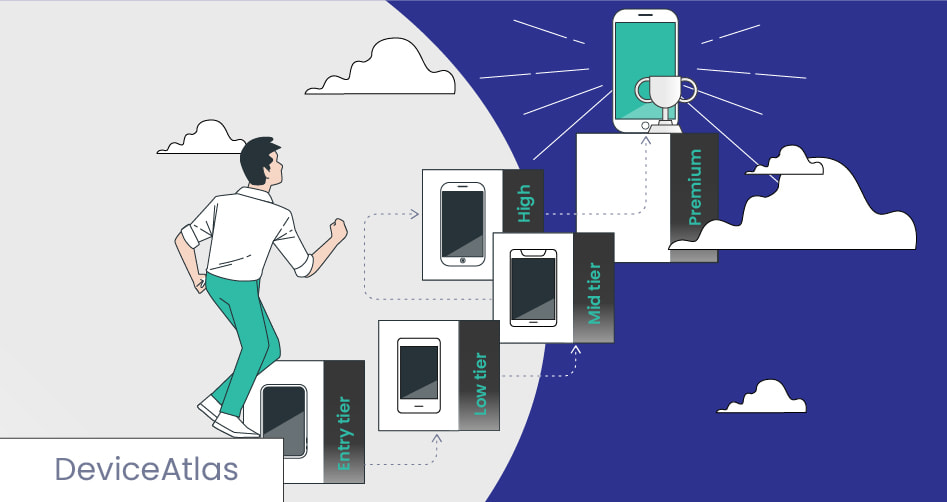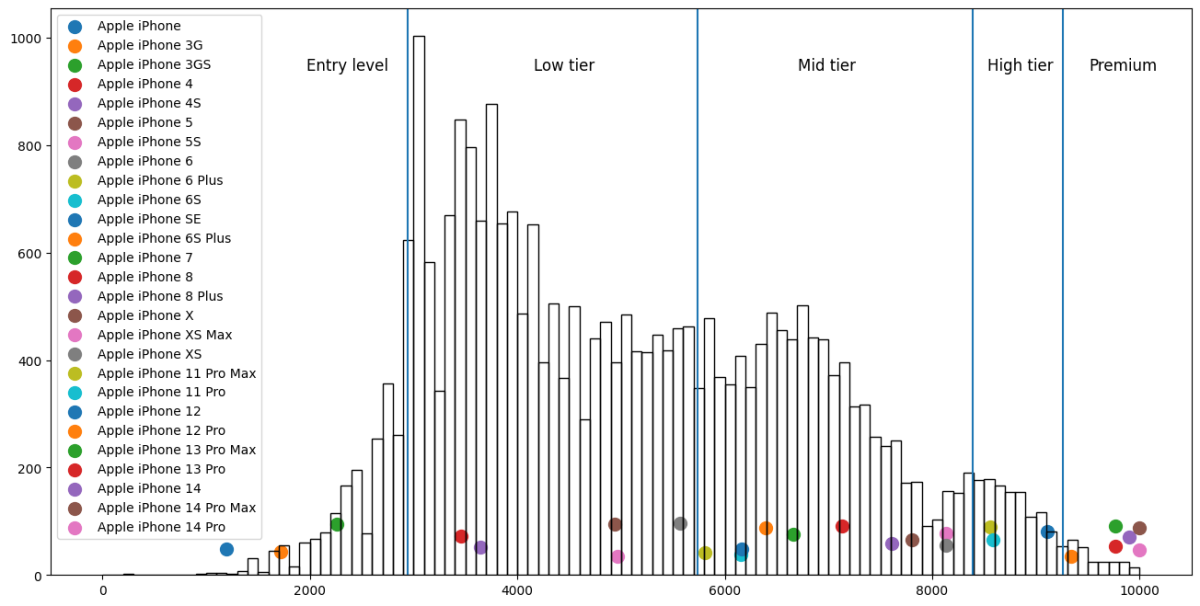
DeviceAtlas has always provided granular information about connected devices, however, putting this information to use is not always trivial. In recent years, we discovered that customers wanted a simple way of categorizing their device traffic, particularly mobile traffic, without having to implement fine grained adaptation or targeting. We were often asked for advice on how best to segment the data, to which the recommendation was an analysis of various properties such as screen size, year of release, OS version, etc. – these being good indicators of overall hardware performance and a way of separating premium devices from the lower end ones.
Market Need
However, as more customers sought advice on how to handle and segment device information into broader categories, we realized an opportunity; we could build a new property to automatically segment smartphones into tiers or categories based on the existing properties we recommended our customers to analyze. This would remove an existing complexity on their end and offer a meaningful data point for business decisions around analytics, optimization and targeting. The tiers would be defined as the following: entry level, low tier, medium tier, high tier and premium.
Challenges
As we began developing this new property, it was quickly discovered just how complex it would be. For the first time, we weren’t just providing specific facts about devices, we were now using existing data points to categorize smartphones into a new property which would be dynamic in nature and decay over time – these were new concepts that had to be factored in.
In addition, for this new property to have merit, it was decided that full transparency over our scoring method was required. As a result, the tier into which a mobile phone fitted was published, along with the hardware score underlying that device. The hardware score (which is a numerical representation of the hardware capabilities), is normalized on a scale of 0-10000 and once it reaches a certain number, that becomes the next tier.
Publishing the hardware score allowed us to preserve the principle that a customer could create their own rules or categories if our designations didn’t match theirs – the hardware score was the underlying metric that customers could use for their own purposes. For example, if they wanted to create 6 segments or 3 segments, they could easily do so by studying the scores and deciding where to draw the lines between tiers.
Democratizing Device Brands
One of our initial considerations was that the brand name is significant in whether a smartphone is considered premium or not. For this new property, it was decided that we would focus on the hardware capabilities rather than the brand, and the property was named hardware classification. This would also level the playing field because lesser known smartphones could still be considered premium tier; part of our goal was to democratize the landscape.
However, one adjustment needed to be made based on the brand name. CPU specs in Apple phones tend to be lower than in Android but still deliver a high performance. So we had to account for that in the classification of those devices to counterbalance the fact that the specifications are generally lower. There was also the recognition that a phone might be considered premium if it has exceptional characteristics in one area. For example, a phone that has an exceptional camera but not necessarily great characteristics across the board may still deserve to be classified as a premium device just on the strength of the camera. Below are two graphs illustrating device distribution over several years according to our hardware classification tiers.

The Apple graph shown below is a good indicator of how device characteristics decay over time as newer models are introduced. In 2007, the iPhone would have been classified as a premium tier device, while in 2023 it’s considered entry-level.

How the Hardware Classification Property is Used
Analytics
Many business decisions are born as a result of analytics reporting and of the most powerful ways that the hardware classification property can be used is through analytics. A DeviceAtlas customer can look at their analytics platform and examine the extent to which device characteristics influence business outcomes. For example, premium tier smartphones might convert better than lower end ones. Low end or entry level phones may deliver a poor experience for users – usually as a result of page weight – and this presents an opportunity to improve the experience for those users.
Optimization
Analytics insights will naturally feed into optimization: implementing improvements to user experiences based on learnings from analytics. For example, certain actions can be taken to cater for mid-tier and low-tier phones experiencing higher bounce rates. Serving a lighter page – reducing image size, JavaScript, etc. – to lower end devices may improve the experience. The efficacy of this can be monitored by subsequently going back to the analytics reports and analyzing improved engagement.
Targeting
Based on analytics, there may be particular patterns or propensity to purchase, etc. and this could be maximized through specific targeting: “how can I target high-tier phones so they produce better results?” For example, different offers or product recommendations might be made to users with a premium tier device rather than those using an entry level device.
Within the AdTech vertical, some DSPs don’t focus on granular device targeting (e.g. focusing only on Samsung or Oppo smartphones) because it may be too complex for the customer. It may be more intuitive to target by tier as the hardware classification is a democratized way to pinpoint specific data. As there are thousands of different brands out there, device targeting can be challenging and it can also be difficult to build an easy-to-use device targeting interface. DeviceAtlas’s hardware classification property makes this a lot easier with phones being grouped into just five tiers.
In SummaryOur hardware classification property has been hugely valuable to customers since its introduction in 2021, and has seen great interest across a variety of industries from AdTech to Web Analytics, and from Mobile Gaming to Online Payments. The property is currently available for iOS and Android phones and we anticipate extending this to tablet devices in Q3/Q4 of this year.



